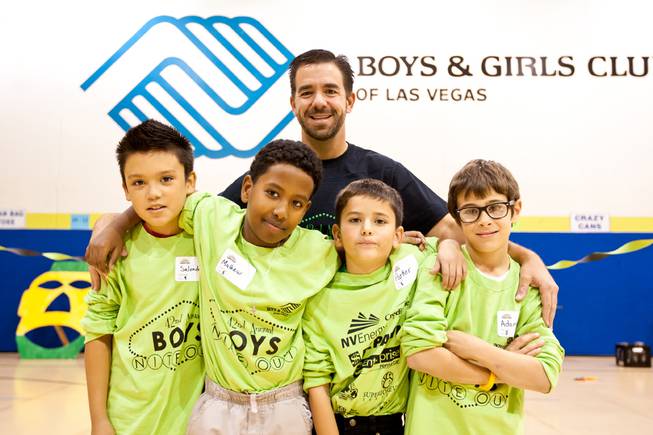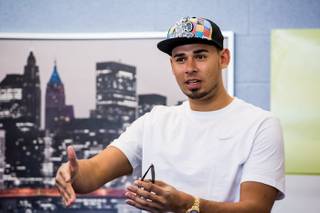
Mona Shield Payne
President and CEO Ken Rubeli poses for a photo with 8- and 9-year-old boys attending the Boys’ Night Out event at the Lied Memorial Boys & Girls Club on Thursday, Nov. 14, 2013.
Monday, Dec. 2, 2013 | 2 a.m.
After more than 50 years operating as separate organizations, the Las Vegas and Henderson chapters of the Boys & Girls Club are joining forces to extend their collective reach throughout the community.
After the formal merger last month, president and CEO Ken Rubeli is laying plans to turn the newly joined organizations into one of the most visible nonprofits in the valley.
As he strolls through the Andre Agassi Clubhouse near Martin Luther King Boulevard and Washington Avenue, which is in the middle of a $100,000 remodeling project, Rubeli lists the ways he envisions the organization growing.
In addition to updating some of the Boys & Girls Club’s 14 existing locations, Rubeli is looking for more ways to open new centers around the valley, whether they’re clubs in low-income apartment complexes or expansions into more affluent areas, like Summerlin, where the Boys & Girls Club has not traditionally had a presence.
He’s also eyeing new ways to increase revenue for the organization, whether it’s expanding its sports leagues, opening haunted houses or launching new programs.
A former casino executive and Wall Street derivatives trader, Rubeli took over as president of the Henderson chapter of Boys & Girls Club in 2010. As the leader of the combined Boys & Girls Club of Southern Nevada, he says he hopes to instill a businesslike culture that will increase dividends for the nonprofit’s shareholders, its kids.
“Like it is in any business, the more efficient we get, everything we do to operate smarter, the more the kids are going to benefit,” said Rubeli, who as a child spent afternoons at the Boys & Girls Club in Scottsdale, Ariz.
The Sun sat down with Rubeli to talk about the merger and the future of the Boys & Girls Club of Southern Nevada:
Can you tell us about the history of the Boys & Girls Club in Southern Nevada?
Both organizations have operated independently for over 50 years. We were both started by Sam Boyd. We’re just like McDonald’s franchises; we have the same national mission that we followed.
Fifty years ago there was a lot of distance between Henderson and Las Vegas, so it made sense to have two different organizations, but over time we just started growing into each other. There was no geographic boundary between the organizations.
How did the merger come about?
We attempted to merge in the 1990s once, and it just wasn’t the right time. We tried again five years ago in 2008 and came real close to merging, but it still wasn’t the right time. About a year and a half ago, we started having very productive dialogue between myself and Dulcinea (Almazan), who was the leader of the Las Vegas organization. Las Vegas has a foundation with resources but it was having some financial challenges. When you own older assets, the upkeep adds up, so there were some financial challenges.
What are the benefits to combining the two chapters?
There are a lot of synergies. As we become more efficient, we have more resources to do stuff for the kids. If we get smarter on how we buy paper towels and stuff like that, the cost-savings trickle down, and now you have more money to spend on programming. We can’t afford to have an arts specialist at every club, but now that we’re bigger, we’re looking at having a specialist who can float around from club to club and really work with the kids. We’re looking at integrating our teen programs, so now if we’re going to do a Friday night dance at one of our clubs, we’re going to bring teens from all over.
How do you see the organization growing in the coming years?
We will continue to look to expand our physical locations and our services. We’ll look to grow smartly; I’m not looking to go do big capital campaigns to build buildings. I’m looking to form truly mutually beneficial partnerships with other nonprofits. There’s a company called Nevada HAND that owns 34 low-income residential communities around town. We’ve opened two clubs with them where we took their 3,000-square-foot activity center in their low-income apartment complex and turned it into a Boys & Girls Club.
Are there plans to expand into new areas?
Our mission is we serve the kids who need us most. There’s the obvious example for kids when both parents are working, they’re economically challenged and, yes, they need to come to us after school. But as we’ve seen at Southern Highlands, which has the highest attendance of any of our clubs, kids need us period. They need a cool place to go after school, get their homework done, hang out with their friends and have fun. In the past we’ve only focused on being where it’s obvious that we’re needed and not realizing that we can go into other neighborhoods as long as the economics make sense. And they do.




Join the Discussion:
Check this out for a full explanation of our conversion to the LiveFyre commenting system and instructions on how to sign up for an account.
Full comments policy